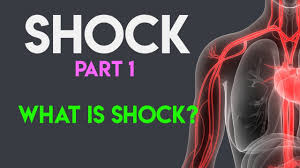Circulatory shock means generalized inadequate blood flow through the body to the extent that the body tis- sues are damaged, especially because too little oxygen and other nutrients are delivered to the tissue cells.
Even the cardiovascular system itself-the heart musculature, walls of the blood vessels, vasomotor system, and other circulatory parts-begins to deteriorate, so the shock, once begun, is prone to become progressively worse.
PHYSIOLOGICAL CAUSES OF SHOCK
CIRCULATORY SHOCK CAUSED BY DECREASED CARDIAC OUTPUT
Shock usually results from inadequate cardiac output. Therefore, any condition that reduces the cardiac out- put far below normal may lead to circulatory shock. Two types of factors can severely reduce cardiac output:M 1. Cardiac abnormalities that decrease the ability of the heart to pump blood.
These abnormalities in- Wclude in particular myocardial infarction but also toxic states of the heart, severe heart valve dys- function, heart arrhythmias, and other conditions. The circulatory shock that results from diminished cardiac pumping ability is called cardiogenic shock.
This condition is discussed in Chapter 22, where it is noted that as many as 70% of people who experi- ence cardiogenic shock do not survive. 2. Factors that decrease venous return also decrease cardiac output because the heart cannot pump blood that does not flow into it.
The most com- mon cause of decreased venous return is dimin- ished blood volume, but venous return can also be reduced as a result of decreased vascular tone, espe- cially of the venous blood reservoirs, or obstruction to blood flow at some point in the circulation, espe- cially in the venous return pathway to the heart.
CIRCULATORY SHOCK WITHOUT DIMINISHED CARDIAC OUTPUT
Occasionally, cardiac output is normal or even more than normal, yet the person is in a state of circulatory shock.
This situation can result from the following:
(1) exces- sive metabolic rate, so even a normal cardiac output is inadequate;
or
(2) abnormal tissue perfusion patterns, so most of the cardiac output is passing through blood vessels besides those that supply the local tissues with nutrition.
The specific causes of shock are discussed later in this chapter. For the present, it is important to note that all of them lead to inadequate delivery of nutrients to critical tissues and critical organs, as well as inadequate removal of cellular waste products from the tissues.
WHAT HAPPENS TO THE ARTERIAL PRESSURE IN CIRCULATORY SHOCK?
In the minds of many physicians, the arterial pressure level is the principal measure of adequacy of circulatory function. However, the arterial pressure can often be seriously misleading. At times, a person may be in severe shock and still have an almost normal arterial pressure because of powerful nervous reflexes that keep the pres- sure from falling.
At other times, the arterial pressure can fall to half of normal, but the person still has normal tissue perfusion and is not in shock. In most types of shock, especially shock caused by severe blood loss, the arterial blood pressure decreases at the same time the cardiac output decreases, although usually not as much.
TISSUE DETERIORATION IS THE END RESULT OF CIRCULATORY SHOCK
Once circulatory shock reaches a critical state of severity, regardless of its initiating cause, the shock itself leads to more shock. That is, the inadequate blood flow causes the body tissues to begin deteriorating, including the heart and circulatory system.
This deterioration causes even greater decreases in cardiac output, and a vicious cycle ensues, with progressively increasing circulatory shock, less adequate tissue perfusion, and more shock until death occurs. It is with this late stage of circulatory shock that we are especially concerned because appropriate physi- ological treatment can often reverse the rapid slide to death.
STAGES OF SHOCK
Because the characteristics of circulatory shock change with different degrees of severity, shock is often divided into the following three major stages:
1. A nonprogressive stage (sometimes called the com- pensated stage), in which the normal circulatory compensatory mechanisms eventually cause full re- covery without help from outside therapy.
2. A progressive stage, in which, without therapy, the shock becomes steadily worse until death occurs. 3. An irreversible stage, in which the shock has pro- gressed to such an extent that all forms of known therapy are inadequate to save the person’s life even though, for the moment, the person is still alive.
We will now discuss the stages of circulatory shock caused by decreased blood volume, which illustrate the basic principles. Then we will consider special character- istics of shock initiated by other causes.
